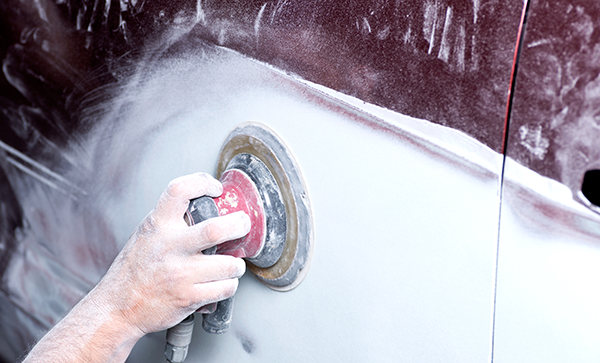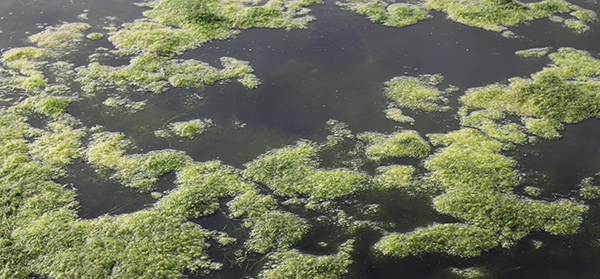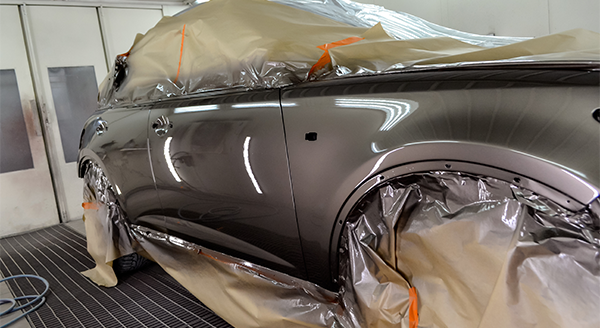P2 Section #4 | Collision Repair & Refinishing - Pg 2

Section 4 | Collision Repair & Refinishing
Revised On: March. 17, 2024 - 8:00 p.m.
Learning Objectives:
- Recognize hazards involved with materials preparation
- Identify P2 opportunities
Material Preparation
Material Preparation is all about getting surfaces ready to be painted or preventing surfaces from being painted. We will cover the major components of Sanding, masking, and cleaning all produce wastes.
Sanding

Sanding is a commonly employed method to eliminate coatings and paints and to even out surfaces where autobody filler is applied. However, if the dust produced during sanding is not adequately ventilated, it can create an unsafe environment. When inhaled, dust particles may contain hazardous and toxic substances that can damage the respiratory and nervous systems. It is important to note that the generated dust is not limited to the immediate workspace; it can spread throughout the facility and even to the surrounding environment. Therefore, it is imperative to take necessary precautions to safeguard oneself and others against the hazards of the dust. Proper ventilation systems and personal protective equipment can minimize the risk of exposure to toxic substances.
Cleaning Solvents

Cleaning a vehicle before painting is essential to ensure the paint adheres properly. This can include the use of petroleum-based solvents or solvent-containing products. Solvents are substances that can dissolve or disperse other substances. Solvents allow you to easily remove unwanted material from the surface of another material. Petroleum-based solvents are the most commonly used for cleaning applications in the automotive industry. Many organic solvents, such as petroleum-based solvents, are categorized as volatile organic compounds. VOCs as they readily emit gasses at normal ambient temperatures and pressures. Due to this, there are more considerations regarding exposure to these chemicals and air quality.
Petroleum solvents are widely available, effective, and generally low cost, but there are health and environmental considerations that come with using them. Some common examples of petroleum solvents are mineral spirits, naphtha, benzene, toluene, xylene, and kerosene. These solvents impact human health by potentially leading to
- Respiratory irritation through inhalation that causes coughing, throat irritation, and difficulty breathing.
- Skin irritation through contact leads to redness, itching, and dermatitis.
- Eye irritation through splashes or exposure causes redness and tearing.
- Cancer risk: some hydrocarbon solvents have been classified as possible or probable carcinogens by organizations like the International Agency for Research on Cancer (IARC).
The environmental effects can come from everyday use, improper disposal, or accidents. Regular use releases gasses that degrade air quality and contribute to ground-level ozone. Ozone gas molecules are composed of three oxygen atoms. The presence of ground-level ozone can damage vegetation and ecosystems. Particularly, it can cause mass die-off in crops, reducing growth and increasing plant disease. Some petroleum solvents may also contribute to greenhouse gasses. Improper disposal or accidental spills can contaminate soil and make its way into the groundwater. However, petroleum-based solvents can biodegrade to non-harmful substances due to naturally occurring bacteria in the environment.
Cleaning Detergents
Detergents are an alternative to cleaning with solvents. Detergents work by lifting away contaminants instead of dissolving them like solvents. The harms of detergents are from direct contact or ingestion. This makes them generally safer to use than solvents, as there are no VOC considerations. If detergents are ingested, severe health effects may be caused, such as:
- Loss of vision,
- Severe abdominal pain and vomiting,
- Rapid low blood pressure.
Ingestion of any automotive chemical warrants a trip to the hospital or a call to poison control. Never swallow any detergents, as they can change the pH level of your blood, disrupt your GI tract, damage your circulatory system, and more.
Understanding the hazards of dermal exposure is crucial for ensuring worker safety and health. The skin is the body's largest organ, capable of absorbing up to 60% of whatever it comes into contact with. Exposure to detergents can lead to rashes and burning sensations, which can cause burns in severe cases. Some detergents are known to cause necrosis to the skin. Detergents can cause even greater damage to the mucous membranes or your eyes. Exposure to harmful substances through the skin can have severe consequences on a worker's health, leading to long-term illnesses and bodily injuries. Therefore, it is vital to implement protective measures to mitigate the risks associated with dermal exposure.
Car fluids, including detergents, pose a significant threat to aquatic life and the environment. Plankton, which plays a crucial role in the survival of aquatic life, can easily get contaminated by car fluids of all kinds. The problem is that it's hard to detect and track this type of contamination once it enters water bodies. Detergents can also enter water bodies through stormwater runoff or storm drains, which do not undergo treatment. These detergents can kill fish eggs and create abnormalities in adolescent fish, damaging their mucous membranes and making them more susceptible to bacteria.
Phosphate-based detergents are effective in cleaning cars, as they can break down dirt, stains, and grease. However, the downside to using these detergents is that when they end up in waterways, they can cause significant damage. This is because high phosphate levels in lakes and rivers can lead to eutrophication, which is the over-enrichment of water by nutrients like nitrogen and phosphorus.

This excess of nutrients can cause a chain reaction that leads to algal blooms and dead zones, characterized by a lack of oxygen and the death of aquatic life due to the inability of sunlight to penetrate the water. It is essential to be mindful of the impact of phosphate-based detergents on the environment and take appropriate measures to prevent them from entering waterways. Water degradation can have far-reaching effects, altering riparian (area between land and river/stream) ecosystems and even degrading drinking water. If detergents contact the water supply, communities that rely on that water source may become ill.
Masking

Materials used in masking would generally be considered solid waste. Solid waste is any material being discarded and doesn’t necessarily have to be physically solid. The wastes to reduce here include paper, tape, and/or plastic sheeting. Reducing the amount of waste that makes it to the landfill is always a benefit to the environment. This isn’t just preventing waste from entering a landfill, but it also contributes to lowering the demand for products to be made. Paint residue dried on masking materials may be considered hazardous if toxic heavy metals within the paint, such as zinc, lead, or manganese.
P2 Opportunities
- Use masking materials sparingly and reuse them where possible. Reduce waste generation from masking by accurately using masking materials when prepping a surface for painting or by reusing materials from different jobs.
- Use products made from recycled or sustainable materials. How a product is made is an important consideration when sourcing materials or products. This brings back the life cycle perspective where not just how a product will be disposed of should be considered.
- Limit the use of solvents for cleaning. Solvents should only be used when absolutely necessary. Other methods, such as detergents and water, should be attempted prior to using the harsher cleaning solvents. Manufacturer specifications for maintenance and cleaning should be followed.
- Implement the use of reusable rags. This prevents the generation of unnecessary hazardous wastes while reducing regulatory burdens through the solvent-contaminated wipes rule | See ADEQ Guidance >
- To minimize airborne dust, use dust extraction systems or equipment that collects the particles as sanding is completed. Ventilated sanders are recommended sanding equipment as they have built-in controls to capture dust being generated.
In the next lesson, we will talk about Painting and Wraps.
